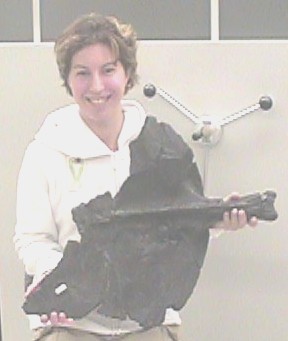(power in numbers)
![]()
![]()

Carleton student Liz Cornejo with Dunkleosteus head shield from Ohio; Canadian Museum of Nature. Photo by Annetta Markussen-Brown
|
This group contains two-thirds of the placoderms and is the only group to have 2 pairs of upper jaw tooth-plates (called supergnathals). The skull has regular pattern of bones with the eyes located at the sides of the head and a separate cheek unit that hinged along the side of the skull roof. The head and trunk shield ere joined by a ball and socket type joint in all advanced arthrodires. In primitive groups such as actinolepidoids they had a sliding neck joint. Arthrodires had shark-like bodies with a single dorsal fin, broad fleshy paired pectoral and pelvic fins and an anal fin. The tail was primitively covered in scales but naked in more advanced forms. Arthrodira includes many different families but in general are divided into the primitive groups having long trunk shields with large spinal plates and the advanced groups having shortened trunk shield with reduced spirals and some with pectoral fins not fully enclosed by the trunk shield without a spinal plate. Arthrodires are usually 20 to 30 cm long. Extreme elongation of the armour is seen in forms like Rolfosteus and Tubonasus which evolved tubular snouts to improve their streamlining. These fishes were only about 30cm long and may have been active top-water predator, probably chasing the small shrimp-like crustaceans in warm tropical waters. The largest of these fish had skull roofs more than a metre long which suggest total lengths of 6 to 8m such as the Dunkleosteus and Gorgonichthys had pointed cusps on the lower and upper jaw tooth plates. The cutting edges of the teeth were kept sharp by abrasion between tooth plates as they occluded. This abrasion was closely matched by growth on the opposite side of the tooth plate, maintaining a sharp cutting surface throughout the life of the fish and up to several cm of bone was lost to self-sharpening. |

Dunkleosteus from the Upper Devonian of Cleveland, Ohio. Karl Albert Frickhinger, 1995. |
Dunkleosteus was a giant dinichthyid from the late Devonian. It‰s body length reached up to about 6m of which 1.5m was armoured. Many Dunkleosteus bones display puncture wounds and deep gouges that seem to correspond in size to cusps on the tooth plate. In some cases there are paired puncture wounds, spaced like the two principal fangs of a large Dunkleosteus. These wounds show evidence of the aggressive nature of Dunkleosteus and its relatives. |